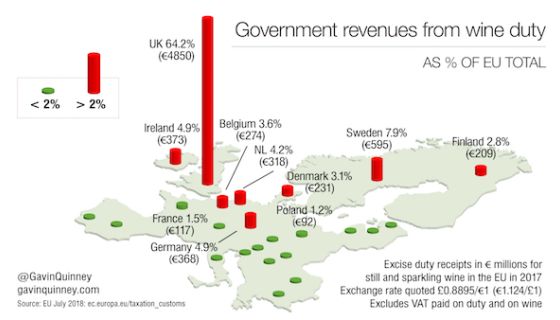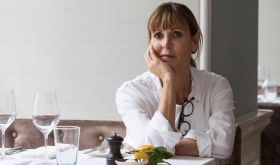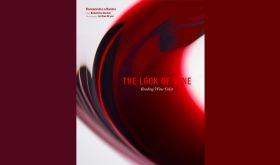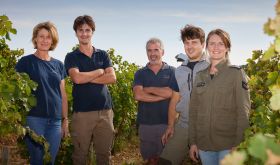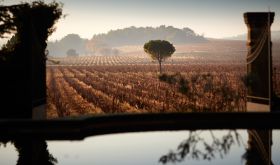Today, with sneakily little fanfare, UK duties on wine are increased across the board. In the 2018 autumn budget, much was made of a freeze on duties on spirits and beer, but poor old wine copped it again, with duty increases that come into effect today: an additional 8p to VAT-inclusive £2.68 a bottle on still wine and 11p to £3.43 a bottle on sparkling wine. See our old friend Gavin Quinney’s 19 unpalatable truths about UK wine duty, from which this chart showing the variation in wine duties in Europe comes.

The Wine Society has announced that they are trying to hold prices on as many lines as possible, and have sportingly published a list of price rises that will be imposed on 14 February, urging their members to stock up on them in advance. Presumably in general these increases will take a little time to work through the distribution pipeline so prices shouldn’t immediately rise today, but don’t expect to see wine getting any less expensive in the UK.
At least we should be ok for Australian and Chilean wine in the horrible event of a no-deal Brexit. Australia signed a wine trade agreement with the UK just in time for the recent Australia Trade Tasting on 22 January and, according to Drinks Business yesterday, the Chileans have followed suit. Clearly these two countries have some particularly nifty trade negotiators. They were the first two countries to have negotiated duty-free access to the potentially lucrative Chinese market and are now reaping the rewards.
Last night I attended a black-tie dinner in Vintners’ Hall organised by the trade organisation Wine GB to celebrate just how well things are going for English and Welsh wine. Wine GB president Camilla, Duchess of Cornwall (who drank red wine throughout), was a real sport and reminded us all of how wine-trade blood flows through her royal veins. In the 1920s her grandfather P Morton Shand wrote well-regarded books on the wines of France and A Book of Other Wines – Than French. She assured us that, were he alive today, he would have devoted a book to English wine. Her father Bruce Shand ran wine merchant Block, Grey & Block on the site of what is Harry’s Bar today, and gave the late Harry Waugh his entrée into the wine trade.

The chairman of Wine GB Simon Robinson of Hattingley Valley (sitting on the Duchess's left, Master of the Vintners on her right) announced that 2018 was the year that English and Welsh wine ‘came of age’, producing a record vintage of 15.6 million bottles. (The comparable figure for frost-shrunk 2017 was just 6 million.) We were reminded of the industry’s climate-change-fuelled transition from sparkling to still wine production by the likes of Gusbourne’s red-labelled Pinot Noir (£24) and Woodchester Valley, Culver Hill 2017 gold-medal-winning white blend (£10.99). I learnt from Fiona Shiner of Woodchester Valley, who grow some Sauvignon Blanc, that her NZ-trained winemaker observed that he had to add far less sugar for chaptalisation to this Gloucestershire fruit than he had needed in Marlborough.
English wine continues its growth with an estimated two million new vines going into the ground this year, plus all sorts of export and tourism initiatives. There is even a plan for a wine trail in Yorkshire. Simon Robinson predicted that eventually 20–30% of English wine will be exported and reported that Hattingley already export more than 30%.
Proudly reminding the 100-plus attendees in Vintners’ Hall that two champagne houses had already invested in English vineyards, Taittinger’s 69 ha (170 acres) in Kent and Pommery’s 40 ha in Hampshire, he predicted more foreign investment and promised to welcome it with open arms.

